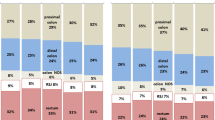Abstract
Background
Conflicting results on the shift of right–left ratio in colon cancer incidence have been reported. We examine incidence trends by subsite in a population-based study.
Materials and methods
Colorectal cancer cases diagnosed in the 1985–2005 period were identified through the Tuscany Cancer Registry. Colon subsite was defined as proximal and distal; gender, age at diagnosis, histology, and stage were analyzed. Average annual incidence and age-specific rates according to subsite were calculated.
Results
A total of 21,160 colorectal cancer cases were extracted; in 18,311 cases, the subsite was identified: 6,916 rectal, 5,239 proximal, and 6,156 distal. A larger proportion of distal colon cancers presented as early stage when compared with proximal. Incidence of rectal and distal colon cancer remained stable, while proximal colon cancer incidence increased.
Conclusions
Proximal colon cancer incidence rate increased through the period. Temporal variations in the incidence rate by subsite could suggest different carcinogenic pathways of right- and left-sided colon cancer.




Similar content being viewed by others
References
Murphy G, Devesa SS, Cross AJ et al (2011) Sex disparities in colorectal cancer incidence by anatomic subsite, race and age. Int J Cancer 128(7):1668–1675
AIRT Working Group (2006) Italian cancer figures–report 2006: incidence, mortality and estimates. Epid Prev 30(suppl 2):36–37
Larsen IK, Bray F (2009) Trends in colorectal cancer incidence in Norway 1962–2006: an interpretation of the temporal patterns by anatomic subsite. Int J Cancer 126:721–732
Koushik A, Hunter DJ, Spiegelman D et al (2007) Fruits, vegetables, and colon cancer risk in a pooled analysis of 14 cohort studies. J Natl Cancer Inst 99:1471–1483
Chauvenet M, Cotte V, Lepage C et al (2011) Trends in colorectal cancer incidence: a period and birth-cohort analysis in a well defined French population. BMC Cancer 11(1):282–296
Meguid RA, Slidell MB, Wolfgang CL, Chang DC, Ahuja N (2008) Is there a difference in survival between right- versus left-sided colon cancers? Ann Surg Oncol 15(9):2388–2394
Cucino C, Buchner AM, Sonnenberg A (2002) Continued rightward shift of colorectal cancer. Dis Colon Rectum 45:1035–1040
Saltzstein SL, Behling CA (2007) Age and time as factors in the left-to-right shift of the subsite of colorectal adenocarcinoma: a study of 213,383 cases from the California Cancer registry. J Clin Gastroenterol 41:173–177
Crerand S, FeeleY TM, Waldron RP et al (1991) Colorectal carcinoma over 30 years at one hospital: no evidence for a shift to the right. Int J Colorectal Dis 6:184–187
Thygesen LC, Gronbaek M, Johansen C (2004) Colorectal cancer in Denmark 1943–1997. Dis Colon Rectum 47:1232–1241
Young JL Jr et al (eds) (2001) Surveillance, Epidemiology and End Results (SEER) Summary staging manual 2000: codes and coding instructions. National Cancer Institutes, Bethesda
Siegel RL, Jemal A, Ward EM (2009) Increase in incidence of colorectal cancer among young men and women in the United States. Cancer Epid Biomarkers Prev 18(6):1695–1698
Lemmens V, van Steenbergen L, Janssen-Heiinen M et al (2010) Trend in colorectal cancer in the south of the Netherlands 1975–1007: rectal cancer survival levels with colon cancer survival. Acta Oncol 49(6):784–796
Cheng L, Eng C, Nieman LZ et al (2011) Trends in colorectal cancer incidence by anatomic site and disease stage in the United States from 1976 to 2005. Am J Clin Oncol 6. doi:10.1097/COC/0b013e3181fe41ed
Siegel RL, Ward EM, Jemal A (2012) Trends in colorectal cancer incidence rates in the U.S. by tumor location and stage, 1992–2008. Cancer Biomarkers Prev. doi:10.1158/1055-9965.EPI-11-1020
Naka T, Kato J, Kawamoto H et al (2008) Differences between right and left-sided colon cancer in patients characteristics, cancer morphology and histology. J Gastroenterol Hepatol 23(3):418–423
Toyoda Y, Nakayama T, Ioka A et al (2009) Trends in colorectal cancer incidence by subsite in Osaka, Japan. Jpn J Clin Oncol 39(3):189–191
Snaebjornsson P, Jonasson L, Jonsson T et al (2010) Colon cancer in Iceland—a nationwide comparative study on various pathology parameters with respect to right and left tumor location and patients age. Int J Cancer 127:2645–2653
Ponz de Leon M, Marino M, Benatti P et al (2004) Trends of incidence, subsite distribution and staging of colorectal neoplasms in the 15-year experience of a specialized cancer registry. Ann Oncol 15:940–946
Erkek B, Ozkan N, Bayar S et al (2007) Subsite distribution of colorectal carcinoma and implication for screening: a retrospective audit of 1771 cases. Hepatogastroenterol 54(73):77–80
Wu X, Chen VW, Martin J et al (2004) Subsite specific colorectal cancer incidence rates and stage distribution among Asians and Pacific Islanders in the United States, 1995 to 1999. Cancer Epidemiol Biomarkers Prev 13(7):1215–1222
Park SY, Lee HS, Choe G et al (2006) Clinicopathological characteristics, microsatellite instability, and expression of mucin core proteins and p53 in colorectal mucinous adenocarcinomas in relation to location. Virchows Arch 449:40–47
Papaxoinis K, Triantafyllou K, Sasco AJ et al (2010) Subsite-specific differences of estrogen receptor beta expression in the normal colonic epithelium: implications for carcinogenesis and colorectal cancer epidemiology. Eur J Gastroenterol Hepatol 22(5):614–619
Acknowledgments
The authors thank A. Corbinelli, T. Intrieri, G. Manneschi, L. Nemcova, and C. Sacchettini (Tuscan Cancer Registry).
Author information
Authors and Affiliations
Corresponding author
Rights and permissions
About this article
Cite this article
Caldarella, A., Crocetti, E., Messerini, L. et al. Trends in colorectal incidence by anatomic subsite from 1985 to 2005: a population-based study. Int J Colorectal Dis 28, 637–641 (2013). https://doi.org/10.1007/s00384-013-1672-2
Accepted:
Published:
Issue Date:
DOI: https://doi.org/10.1007/s00384-013-1672-2




